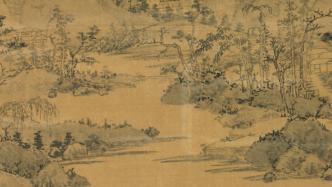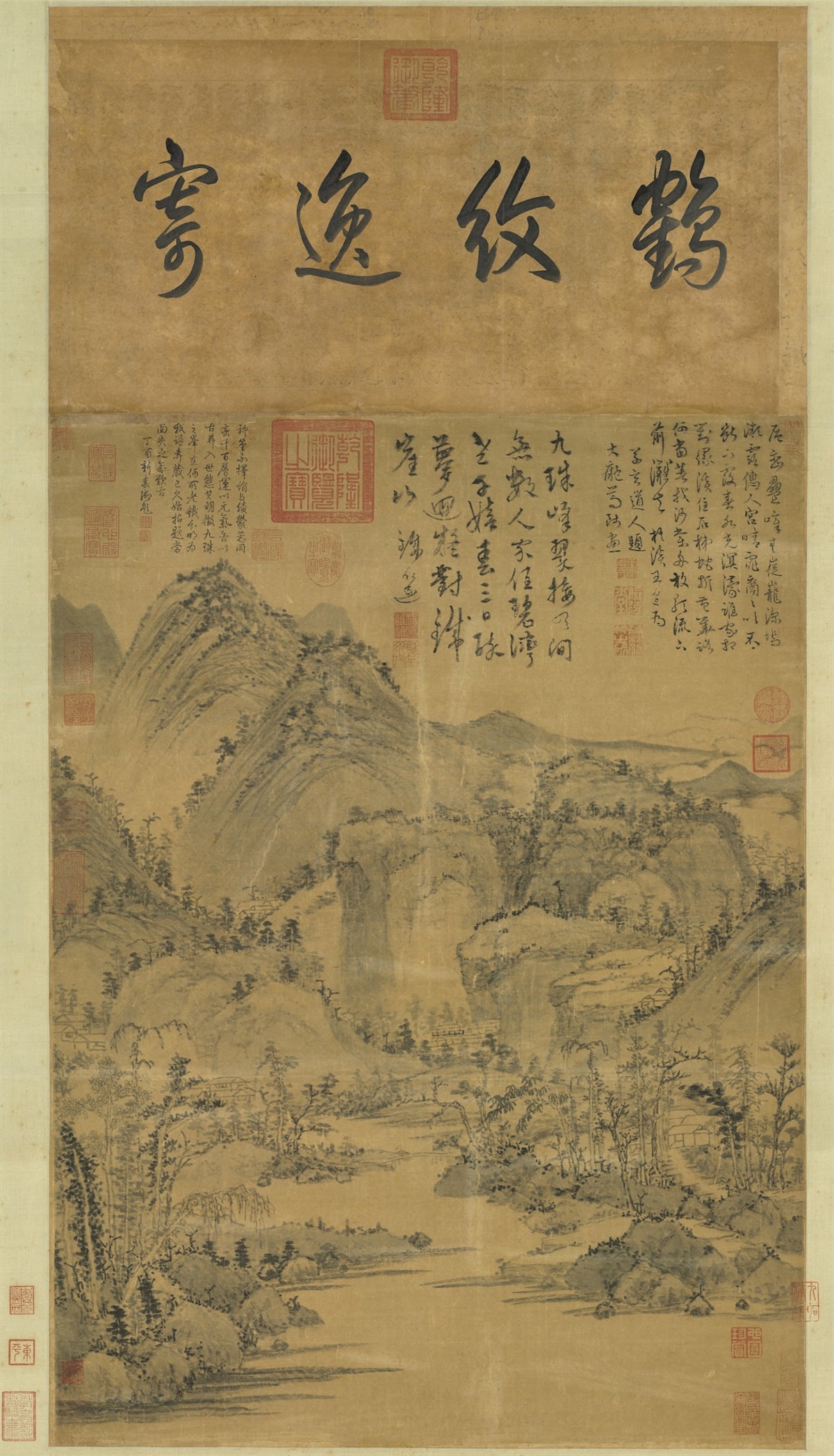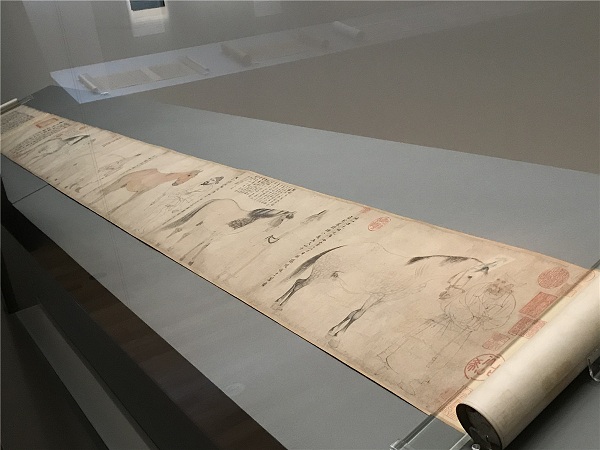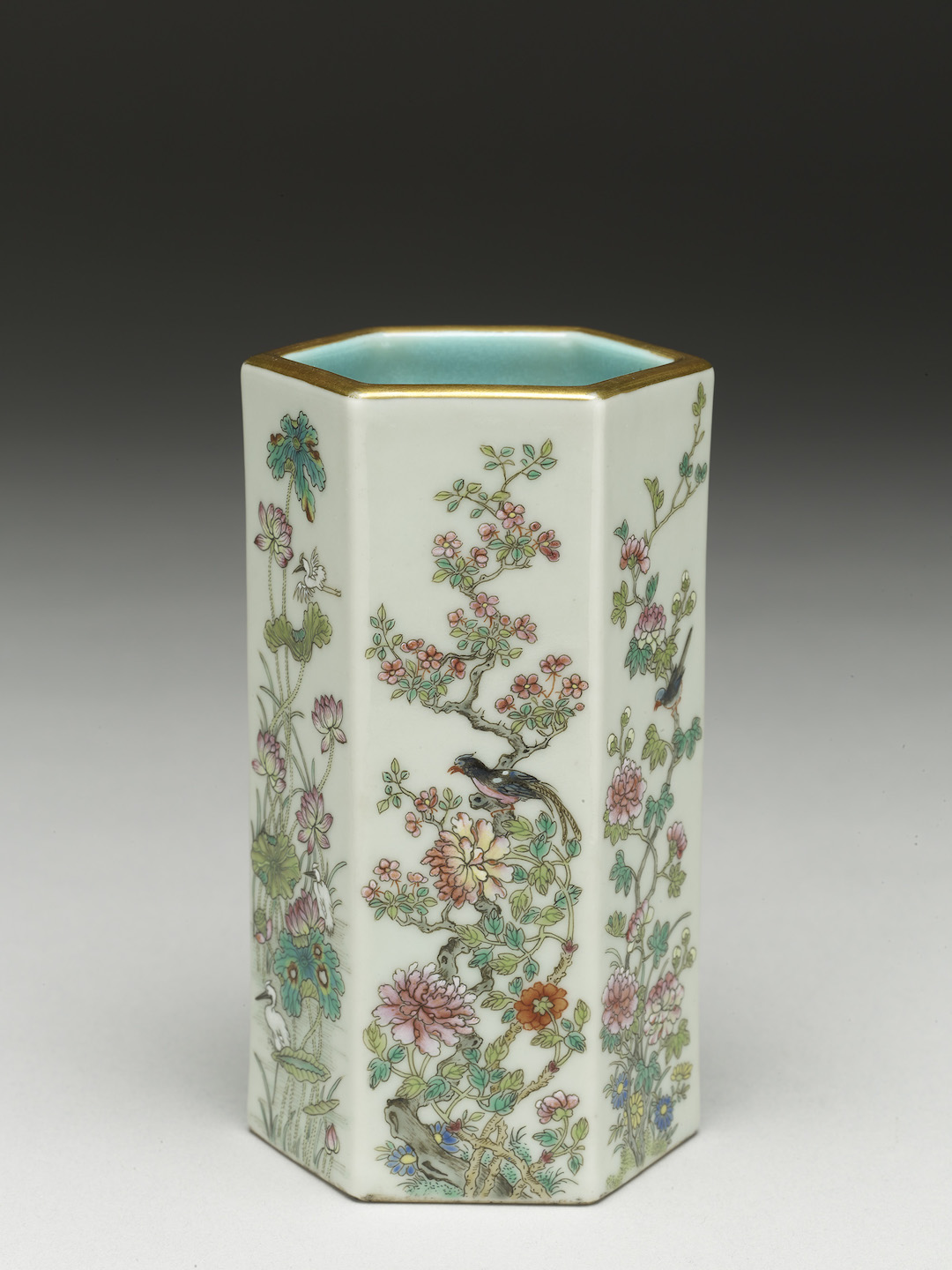
Huang Gongwang, a painter of the Yuan Dynasty, was ranked first among the "Four Yuan Masters". His handed down paintings include "Dwelling in the Fuchun Mountains" and "Nine Peaks with Snow", all of which have his own inscriptions and postscripts.
The Paper has learned that recently, the National Palace Museum in Taipei ushered in the "National Treasure Focus" exhibition. The exhibition presented a painting of "Nine Everests". This painting did not leave Huang Gongwang's inscription or imprint, but experts believe that through The inscriptions and postscripts of Yang Weizhen and others in the Yuan Dynasty, as well as the painting methods of clouds, mountains, trees, rocks, and huts in the paintings, can definitely be attributed to Huang Gongwang's handwriting. In addition, "Nine-Pearl Peak Green" is painted on a piece of patterned "silk" instead of the usual "paper" or "silk". This is the earliest known example of painting on "Hua Ling". This exhibition uses image processing to clearly reconstruct for the first time the pattern of the flower damask - the luan and magpie cloud pattern.

Huang Gongwang, a painter of the Yuan Dynasty, ranked first among the "Four Yuan Painters"
"Nine Evergreens" without the author's signature
In terms of painting style, Huang Gongwang advocates nature and emphasizes freehand brushwork. In his later years, he often stayed in the Fuchun Mountain area, often carrying paper and pen to depict the natural scenery of Yushan, Sanmao, Jiufeng, Fuchun River and other places. He carries a pen and paper with him and writes down the sights that excite him immediately. Because his creations come from his personal experience of natural scenery, he combines his indifferent and peaceful emotions with the charm of mountains and rivers, thus achieving the most beautiful realm of natural harmony. His brushwork and ink are simple and elegant, his style is vigorous and broad, and his momentum is majestic. He created shallow crimson landscapes with a majestic, simple and bright painting style, which had a great influence on landscape paintings of the Ming and Qing Dynasties.
"Nine Everest Peaks" does not leave any inscriptions or imprints of Huang Gongwang from the Yuan Dynasty, but the painting methods of clouds, mountains, trees, rocks, and huts all reveal his preferred shapes and habits of using the brush in the center. It can be determined that it came from Huang Gongwang's handiwork is undoubtedly his.

Wang Feng wrote a poem on the painting
Researchers believe that the last line of the poem written by Wang Feng (1319-1388) on the painting reads: "The painting was inscribed for Taoist Caoxuan (Yang Weizhen) to honor his master (Huang Gongwang)", which provides strong circumstantial evidence that the author is Huang Gongwang.

Yang Weizhen's poems
The first line of the poem written by Yang Weizhen (1296-1370): "Nine-Ever Peak Green connects the clouds", which became the source of the name of this painting "Nine-Ever Peak Green".
Taoist painter Huang Gongwang
Huang Gongwang (1269-1354), a native of Changshu. His original name was Lu Jian. Because his parents died young, he was adopted as a son by the elderly Huang family. Therefore, he changed his name to Huang Gongwang, with the courtesy name Zijiu.

Yuan Dynasty Huang Gongwang's "Nine-Pearl Peak Green"
Huang Gongwang was smart since he was a child. At the age of 24, without the imperial examination system, he successfully entered the narrow gate of government agencies and served as a scribe in the supervisory unit in Hangzhou. When he was about 48 years old, he was recommended to serve in the Beijing Supervisory Yushiyuan. Just when he was developing, he was implicated and imprisoned. After being released from prison, Huang Gongwang, who was nearly fifty years old, gave up his official career and became a Taoist priest of the Quanzhen Sect. Under the nickname "Big Idiot", he preached and practiced Taoism in the south of the Yangtze River. In his spare time, he created many masterpieces and became famous for his painting skills. A model of imitation, he is the author of "The Art of Writing Landscapes".
An interesting Feng Shui treasure land
In the foreground of "Jiu Zhufeng Green", there are several gentle slopes extending into the water, interspersed into winding valleys, and the richly shaped hills in the back are connected and meandering down from the left and right. The objects in the painting appear to be arranged in an "X" shape, subtly directing the line of sight to the central building.

Huang Gongwang, Yuan Dynasty, "Nine-Pearl Peak Green" (detail)
The railings of this building are specially marked with heavy ink, and the fish-tail protrusions on both sides of the roof are different from ordinary houses. It is probably a Taoist temple. In the painting, the surrounding peaks seem to be guarding the palace. The hazy shadows of trees and upright rock walls behind it seem to be filled with spiritual energy. The rows of trees and moss spots on the mountainside embellish the vitality of everything in spring. Surrounded by mountains and water, it contains beautiful scenery. Huang Gongwang not only imitated the literati painting style of Dong Yuan and Ju Ran, but also used the stance of a Taoist priest to present a geomantic treasure protected by palaces and temples!
Rare canvas—Hua Ling
"Nine Everests" is painted on a piece of patterned "silk" instead of the usual "paper" or "silk". This is the earliest known example of painting on "Hua Ling".

Canvas flower damask
The flower damask pattern is obscured by pen and ink, making it difficult to observe. Emperor Qianlong believed that the pattern on the flower damask was a crane, and wrote "Crane Pattern Yiji" on the poem pond. Can you tell it’s a crane pattern? In fact, there is no crane pattern on this piece of silk cloth.
This exhibition specifically uses image processing to clearly reconstruct the pattern of the flower silk - the luan and magpie cloud pattern for the first time. This set of patterns includes two phoenixes and four magpie birds flying up and down, as well as surrounding cloud patterns. The luan and magpie shapes are delicate and strong, as if they are parading high in the sky.
After Huang Gongwang became famous, many people provided good materials and asked him to paint. This piece of silk with a Luan and magpie pattern is said to be a fabric from the Northern Song Dynasty, and it must have been quite valuable at that time. He boldly accepted the creation of this flower damask, carefully managed the layout, and painted this classic work that expresses the Taoist landscape.
(Information for this article comes from the official website of the National Palace Museum in Taipei)


